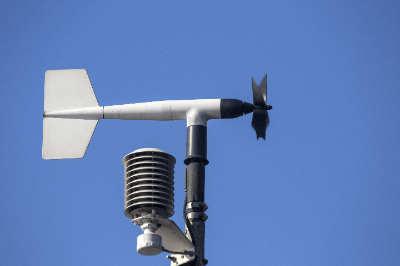What Is an Anemometer?
 An anemometer is a device that measures the speed of the wind. Anemometers measure the speed of the wind and display it in units such as m/s or knots. Anemometers can be used to measure various wind speeds, such as those caused by atmospheric conditions, wind caused by rotation, and wind coming out of air conditioning exhaust vents.
An anemometer is a device that measures the speed of the wind. Anemometers measure the speed of the wind and display it in units such as m/s or knots. Anemometers can be used to measure various wind speeds, such as those caused by atmospheric conditions, wind caused by rotation, and wind coming out of air conditioning exhaust vents.
Wind speed is a vector quantity. For this reason, many anemometers can measure both wind speed, which is a magnitude, and wind direction, which is a direction. Anemometers are available in a variety of operating principles. For example, anemometers include wind cup anemometers, windmill anemometers, ultrasonic anemometers, and thermal anemometers.
Uses of Anemometers
Anemometers are used in many everyday applications. For example, they are used for repair and maintenance of air conditioners, and to measure the anemometric velocity of gases from exhaust vents. Anemometers are also used to determine atmospheric conditions for meteorological observations.
There are several types of anemometers, including windmill, ultrasonic, thermal, and wind cup types. The most common type of anemometer is the windmill type, which is used by organizations, such as the Japan Meteorological Agency. Anemometers of the windmill or wind cup type are used for the purpose of measuring outdoor wind speed. The characteristic feature of their use is that they are installed outdoors and measure the degree of wind speed outside by rotation.
Anemometers of the windmill and wind cup types have been increasingly digitized in recent years. The digitalization of anemometers makes it possible to check the wind speed at a distance from the location where the Anemometer is installed. Real-time wind speed can be checked on a PC or smartphone indoors. Anemometers mainly used indoors are thermal and ultrasonic types. Thermal and ultrasonic anemometers are often portable.
Thermal and ultrasonic anemometers are used by placing the instrument directly on the area where the wind speed is to be measured, or by hand, and by taking continuous measurements on the spot. Both thermal and ultrasonic anemometers provide instantaneous wind speed data at your fingertips. They are also characterized by their flexibility of use, as the installation position can be easily changed. However, care must be taken to ensure that the wind speed is not affected by the movement of people.
Types of Anemometers
In general, to measure wind speed, one must decide the purpose and under what environmental conditions the results are desired. The type of anemometer to be used depends on whether the measurements are to be made indoors or outdoors.
There are four types of anemometers: wind cup anemometers, windmill anemometers, ultrasonic anemometers, and thermal anemometers.
1. Anemometer
Anemometers use a cone-shaped blade called a wind vane. The wind speed is calculated by measuring the number of rotations of the rotating blades with a generator or rotary encoder. The wind speed is not related to the direction of the wind, but only to the wind speed, making it very sensitive to wind changes.
2. Anemometer With Wind Turbine
Anemometers use propeller-like blades that are rotated by the wind. Wind speed is measured by using the rotational speed of the rotating blades, which is measured by a generator or other device. Anemometers that can simultaneously measure wind direction by attaching a propeller to one end of the anemometer and a weathervane to the other end are common.
3. Ultrasonic Anemometer
Anemometers measure wind speed by measuring the amount of change in the speed of sound, which varies with wind speed. The ultrasonic wave is transmitted from the transmitter and received by the receiver, and the time taken from transmission to reception is used to measure the wind speed.
4. Thermal Anemometer
Thermal anemometers use the temperature change of the measuring section cooled by the wind. The anemometer measures the wind speed by measuring the electrical signal generated from the temperature sensing element. Some thermal anemometers can measure not only wind speed but also humidity and pressure at the same time.
How to Select an Anemometer
Anemometers have a variety of measurement principles, so care must be taken when selecting one. For example, some anemometers are resistant to rain and snow, making them suitable for outdoor use, while others are suitable for use in clean rooms and other manufacturing sites where precision is required.
Anemometers should therefore be selected appropriately according to the application for which they are to be used. Anemometers are used at workplaces, to measure the effectiveness of smoke control, and so on. Recently, however, there are more and more opportunities to measure wind speeds close at hand. For example, you may check wind speed and flow when playing golf, sailing or other outdoor activities, or when using the air conditioner at home.
When selecting an anemometer, the most common type of anemometer is the compact type. Anemometers of the compact type are available in windmill and thermal types, and can be purchased at reasonable prices by the public. The advantage of the compact type Anemometer is that it is a handheld type. Anemometers are characterized by their light weight, which makes them convenient to carry.
In addition, since the measurement result display screen is integrated with the instrument, the wind speed measurement results can be checked immediately. Anemometers of the handy windmill type are mainly used for outdoor leisure and sports activities. Thermal anemometers, like windmill anemometers, are also available at reasonable prices. Thermal-type anemometers can be used to measure wind speeds mainly outdoors and at home under conditions where an air conditioner or circulator is used.